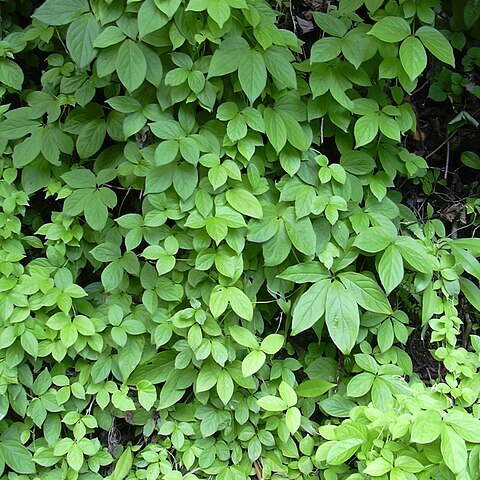Tubers irregular, usually long ovoid; transverse section white when fresh, becoming brown; roots fibrous. Stem twining to left, sparsely puberulent, glabrescent, prickly. Bulblets present. Leaves alternate, palmately 3--7-foliolate; petiole 5--11 cm, densely reddish brown pubescent; leaflets ovate to lanceolate, 6.5--24 × 1.5--9 cm, adaxially glabrous, abaxially appressed pubescent, sometimes glabrescent, pinnately veined, base attenuate into a ± tomentose petiolule, margin entire, apex acute. Male spikes in axillary panicles to 50 cm, often with long, lateral branches; axis brown pubescent. Male flowers: sessile or subsessile; bract and bracteole reniform, forming an involucel around perianth, sparsely hairy, apex cuspidate; stamens 3. Female spikes simple or branched, brown puberulent. Female flowers: bracts, perianth, and ovary hairy. Capsule black at maturity, long ellipsoid, 2--2.5 cm, thinly leathery, sparsely hairy; wings 0.5--0.6 cm wide. Seeds inserted near apex of capsule; wing pointing toward capsule base. Fl. Aug--Oct, fr. Nov--Feb.
A yam with a climbing vine 2-5 m long. The stems have scattered small spines. There are small tubers found in the axils of the leaves as well as larger underground tubers. The leaves have 5 to 7 leaflets pointed at the tip and 8 to 15 cm long. Often the lower leaves have 5-7 leaflets and upper leaves have 3 leaflets. The leaflets are spread out like fingers on a hand. The leaves are finely hairy. The flowers are small, yellowish white with a slight smell and borne in large numbers of flower clusters in the axils of leaves. The male flower spikes are 10-18 cm long and mostly occur as two together in the axil of a leaf. The female spikes occur as 1-3 together and are as long as the male ones. The fruit are winged capsules 8-12 mm long by 6-9 mm wide. The tubers vary in colour and shape. Often they are round and covered with long hairs.
For variety occurring in Australia see Dioscorea pentaphylla var. papuana Burkill.

